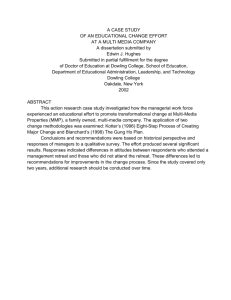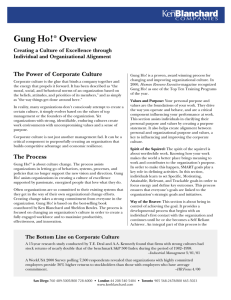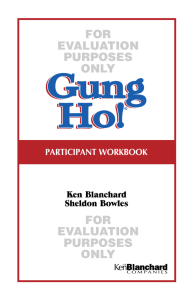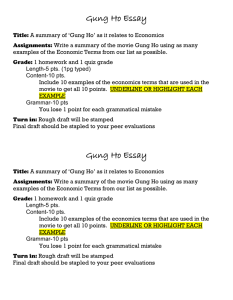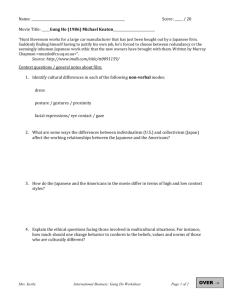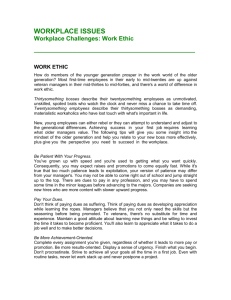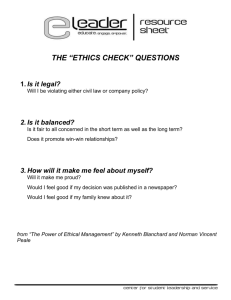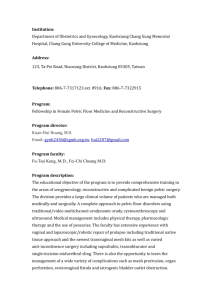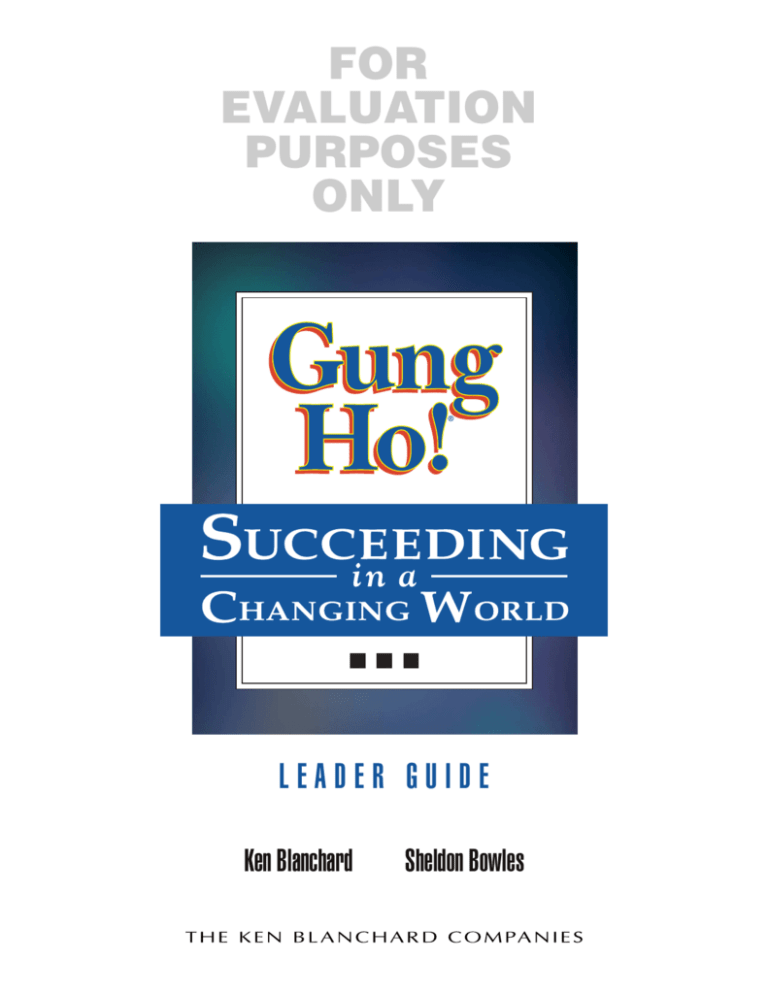
FOR
EVALUATION
PURPOSES
ONLY
LEADER GUIDE
Ken Blanchard
Sheldon Bowles
AUTHORS
Ken Blanchard
Sheldon Bowles
PROJECT MANAGER
Krisa Brillantes
INSTRUCTIONAL DESIGN
Krisa Brillantes
Rob Brillantes
PRODUCTION MANAGER
Tara Wallace
LAYOUT AND DESIGN
Tara Wallace
Beverly Haney
FOR
EVALUATION
PURPOSES
ONLY
PRODUCTION
Carla deBose
PROOFING
Linda Hulst
Patrice DeVeau Simpson
PRINTING
IKON Office Solutions
The materials in this program have been designed to develop certain and specific
knowledge and skills. Our staff has spent a significant amount of time and effort writing and
testing these materials to ensure that they are effective for their purpose. The Ken Blanchard
Companies maintains full and exclusive rights to these materials through all applicable
copyright laws. No redesign, editing, or reproduction of these materials is permitted without
written permission of The Ken Blanchard Companies.
If you desire to customize or adapt these materials for your organization or to discuss
a licensing agreement, please contact your Learning Materials product specialist at
800 728-6052. The Ken Blanchard Companies maintains a staff with extensive capabilities
to assist you in meeting your needs.
All changes, adaptations, or licensing rights to these materials must be requested and
approved through The Ken Blanchard Companies in writing.
Thank you!
125 State Place, Escondido, CA 92029 USA
San Diego 760 489-5005 • 800 728-6000 • Fax 760 489-8407
London 44 208 540 5404 Toronto 905 568-2678 • 800 665-5023
www.kenblanchard.com
Item # 10838
Web V100699
LEADER GUIDE
Table of Contents
Training Preparation
Introduction ................................................................................................ 3
Training Session Checklist ........................................................................... 4
Tips for Transferred Learning ....................................................................... 5
Session Agenda ........................................................................................... 6
Optional Session Agendas ........................................................................... 7
Training Session
Introduction .............................................................................................. 11
The Three Principles of Gung Ho! ............................................................. 12
Spirit of the Squirrel .................................................................................. 13
Spirit of the Squirrel Exercise ..................................................................... 15
Spirit of the Squirrel Action Plan ............................................................... 17
Way of the Beaver ..................................................................................... 18
Way of the Beaver Exercise ....................................................................... 20
Way of the Beaver Action Plan .................................................................. 22
Gift of the Goose ....................................................................................... 23
Gift of the Goose Exercise ......................................................................... 25
Gift of the Goose Action Plan .................................................................... 27
Closure ..................................................................................................... 28
Session Evaluation ..................................................................................... 29
FOR
EVALUATION
PURPOSES
ONLY
Appendix
Sample Invitation Memo ........................................................................... 33
Pretraining Survey ..................................................................................... 34
Session Evaluation Form ............................................................................ 35
Sample Follow-Up Memo ......................................................................... 36
The Ken Blanchard Companies ................................................................. 37
Learning Materials ..................................................................................... 39
Notes ........................................................................................................ 40
© 1999 Blanchard Family Partnership and Ode to Joy Limited. All rights reserved. Do not duplicate • Web V100699
iii
GUNG HO! SUCCEEDING IN A CHANGING WORLD
FOR
EVALUATION
PURPOSES
ONLY
iv
© 1999 Blanchard Family Partnership and Ode to Joy Limited. All rights reserved. Do not duplicate • Web V100699
FOR
EVALUATION
PURPOSES
ONLY
TRAINING
P R E PA R AT I O N
GUNG HO! SUCCEEDING IN A CHANGING WORLD
FOR
EVALUATION
PURPOSES
ONLY
2
© 1999 Blanchard Family Partnership and Ode to Joy Limited. All rights reserved. Do not duplicate • Web V100699
LEADER GUIDE
Introduction
In the book Gung Ho!, Ken Blanchard and Sheldon Bowles introduce us to an
invaluable leadership process, outlining methods to inspire people to change the
way they lead. This video program and its accompanying materials are designed to
complement their book and provide a visual guide for implementing the three
principles of Gung Ho. This program can also be used in conjunction with the
companion video Gung Ho! The Dramatic—which brings the book to life on video.
Participants attending this training session will learn the essential principles of the
Gung Ho theory:
FOR
EVALUATION
PURPOSES
ONLY
• The Spirit of the Squirrel—Worthwhile Work
• The Way of the Beaver—In Control of Achieving the Goal
• The Gift of the Goose—Cheering Each Other On
Before conducting this training session, we encourage you to view the video and
read through this guide at least twice to become comfortable with the format and
subject matter. Whenever possible, incorporate your own experiences and
examples to help illustrate the principles of Gung Ho. Moreover, ask participants
for their examples to contribute to the training. This will ensure that your
participants gain the most from their training experience.
© 1999 Blanchard Family Partnership and Ode to Joy Limited. All rights reserved. Do not duplicate • Web V100699
3
GUNG HO! SUCCEEDING IN A CHANGING WORLD
Training Session Checklist
Prework
❏ Create an Invitation Memo (see appendix).
❏ Make copies of the Pretraining Survey (see appendix) to evaluate the needs of your
participants. This survey will allow you to design the training session to emphasize
areas or topics of importance.
❏ Send prework materials (Invitation Memo and Pretraining Survey) to participants
one to two weeks prior to the training session and ask that the survey be returned
to you at least five days before the training session.
❏ Collect completed Pretraining Survey and measure the current status of
participants.
FOR
EVALUATION
PURPOSES
ONLY
Meeting Preparation
❏ View the video and read through this guide at least twice to become comfortable
with the format and subject matter.
❏ Determine your training objectives.
❏ Choose different ways of training to ensure transfer of information.
Session Materials
❏ Video—Gung Ho! Succeeding in a Changing World
❏ Leader guide
❏ Participant workbooks
❏ Copies of the Session Evaluation Form for each participant (see appendix)
❏ Paper and pens/pencils
❏ Flip chart, flip-chart paper, and markers
Location
❏ Create a relaxed environment.
❏ Make sure all participants have a good view of the visuals.
❏ Ensure that there is enough light for taking notes while viewing the video.
❏ Provide an adequate writing surface for participants.
❏ Check for good acoustics.
❏ Verify that your room is accessible and equipped for participants with disabilities.
Video Equipment
❏ Make sure that the VCR is properly connected to the monitor.
❏ Test the VCR and check the monitor for picture, color, and volume.
❏ Make sure that the tape is rewound before the session.
❏ Check all other equipment for proper operation.
Follow-Up
❏ Create a follow-up memo (see appendix).
4
© 1999 Blanchard Family Partnership and Ode to Joy Limited. All rights reserved. Do not duplicate • Web V100699
LEADER GUIDE
Tips for Transferred Learning
Keep in mind the following tips when teaching adults. You may want to review
these tips and use them when planning the session.
Adults learn when they feel that they need to learn.
Discuss ways the session will help participants improve job performance by
learning how to motivate their teams.
Adults learn through practical application.
Use the exercises found in this leader guide or create your own to give
participants an opportunity to practice skills they can take back to their jobs. Also,
provide reinforcement tools such as copies of the book Gung Ho! and the
participant workbook for your participants to take back to their jobs for
continued and reinforced learning.
FOR
EVALUATION
PURPOSES
ONLY
Adults learn by solving realistic problems.
Discuss and analyze actual on-the-job situations. Allow participants to solve
real-life problems by using what they have learned.
Adults learn in an informal environment.
Design your training room to be as informal as possible. Avoid classroom-style
seating. If appropriate, encourage participants to wear casual clothing. Encourage
discussion and interaction that allow participants to feel more comfortable.
Adults learn by different training methods.
Vary your training methods. Combine discussions, roleplays, case studies,
self-evaluations, and action planning in your training session. Using a variety of
methods reinforces your message and promotes participation.
Trainers learn through follow-up methods.
Follow-up methods are crucial when determining the success of transferred
training. Feedback from your participants’ team leaders; follow-up surveys or
training sessions; three-, six-, and nine-month skill-testing sessions; etc.; can help
you evaluate the information being used on the job.
© 1999 Blanchard Family Partnership and Ode to Joy Limited. All rights reserved. Do not duplicate • Web V100699
5
GUNG HO! SUCCEEDING IN A CHANGING WORLD
Session Agenda
This session agenda has been provided to help guide you through your Gung Ho!
Succeeding in a Changing World training session. You can also follow the optional
agendas, modify them, or create your own agenda to meet the needs of your
participants. This four-hour session can also be extended to a five-hour session by
allowing more time for the exercises and action planning.
Four-hour Session
Activity
Time
Page
FOR
EVALUATION
PURPOSES
ONLY
15 minutes
11
Show First Video Segment and Review/Discuss
30 minutes
13
Spirit of the Squirrel Exercise
20 minutes
15
Spirit of the Squirrel Action Plan
15 minutes
17
Break
10 minutes
Introduction
Spirit of the Squirrel
Way of the Beaver
Show Second Video Segment and Review/Discuss
25 minutes
18
Way of the Beaver Exercise
20 minutes
20
Way of the Beaver Action Plan
15 minutes
22
Break
10 minutes
Gift of the Goose
Show Third Video Segment and Review/Discuss
30 minutes
23
Gift of the Goose Exercise
15 minutes
25
Gift of the Goose Action Plan
15 minutes
27
Closure
15 minutes
28
5 minutes
29
Session Evaluation
6
© 1999 Blanchard Family Partnership and Ode to Joy Limited. All rights reserved. Do not duplicate • Web V100699
LEADER GUIDE
Optional Session Agendas
Option 1
Hold four short sessions that focus on one principle at a time. Allow time between
each session to work on implementing each principle in the workplace.
1st Session
• Watch the entire Gung Ho! Succeeding in a Changing World video
• Complete Spirit of the Squirrel Exercise and Action Plan
• End session; prepare for Way of the Beaver
2nd Session
FOR
EVALUATION
PURPOSES
ONLY
• Report on Spirit of the Squirrel progress
• Watch and review video—Way of the Beaver segment
• Complete Way of the Beaver Exercise and Action Plan
• End session; prepare for Gift of the Goose
3rd Session
• Report on Way of the Beaver progress
• Watch and review video—Gift of the Goose segment
• Complete Gift of the Goose Exercise and Action Plan
• End session; confirm all three principles
Final Session
Report on Gift of the Goose progress and celebrate entire leadership process.
Option 2
Complete the entire Gung Ho! companion video series.
1st Session (2–4 hours)
• Gung Ho! The Dramatic video (See the Two- and Four-hour Sessions in the Gung
Ho! The Dramatic Leader Guide.)
2nd Session (4 hours)
• Gung Ho! Succeeding in a Changing World video (See the Four-hour Session on the
previous page.)
© 1999 Blanchard Family Partnership and Ode to Joy Limited. All rights reserved. Do not duplicate • Web V100699
7
GUNG HO! SUCCEEDING IN A CHANGING WORLD
FOR
EVALUATION
PURPOSES
ONLY
8
© 1999 Blanchard Family Partnership and Ode to Joy Limited. All rights reserved. Do not duplicate • Web V100699
FOR
EVALUATION
PURPOSES
ONLY
TRAINING
SESSION
GUNG HO! SUCCEEDING IN A CHANGING WORLD
FOR
EVALUATION
PURPOSES
ONLY
10
© 1999 Blanchard Family Partnership and Ode to Joy Limited. All rights reserved. Do not duplicate • Web V100699
LEADER GUIDE
R E F E R E N C E
Introduction
At a Glance
Time Required:
• 15 minutes
Material Needed:
• Flip chart
Objective:
• To introduce participants to
each other and create an
environment conducive to
learning
Introduce Session
1. Introduce yourself to the group and ask participants to introduce
themselves and briefly explain their jobs/roles.
2. Describe the agenda for this training session and outline the training
goals.
Introduce Gung Ho!
1. Distribute participant workbooks and encourage participants to take notes
in their workbooks.
FOR
EVALUATION
PURPOSES
ONLY
2. Refer participants to workbook page 2 and make these points:
During the session, you will begin to learn the three leadership
principles for creating a Gung Ho spirit in yourself and your
organization:
• Spirit of the Squirrel—knowing your work is worthwhile
• Way of the Beaver—being in control of achieving the goal
• Gift of the Goose—cheering each other on
These aren’t typical leadership catch phrases; but by the end of
this session, these phrases will have new meanings for you.
Before we get started, let’s take a few minutes to discuss our
personal thoughts on motivated employees.
4. Refer participants to a flip chart with these two headings:
Drawbacks of Unmotivated Employees
Benefits of Motivated Employees
5. Ask participants to brainstorm for ideas that fit under each heading and
then list at least 5–10 ideas under each heading in their workbooks.
6. Emphasize this point:
Obviously, we would all prefer motivated team members to
those who don’t care. But, getting team members to care about
their work is not always easy. Gung Ho provides us with three
important principles for motivating our team and increasing
overall productivity.
© 1999 Blanchard Family Partnership and Ode to Joy Limited. All rights reserved. Do not duplicate • Web V100699
11
GUNG HO! SUCCEEDING IN A CHANGING WORLD
The Three Principles of Gung Ho!
Spirit of the Squirrel—Worthwhile Work
Way of the Beaver—In Control of Achieving the Goal
Gift of the Goose—Cheering Each Other On
FOR
EVALUATION
PURPOSES
ONLY
12
© 1999 Blanchard Family Partnership and Ode to Joy Limited. All rights reserved. Do not duplicate • Web V100699
LEADER GUIDE
REFERENCE
Spirit of the Squirrel
At a Glance
Time Required:
• 30 minutes (22-minute video
segment and 8-minute
discussion)
Materials Needed:
• Video—Gung Ho!
Succeeding in a Changing
World
• Participant workbooks
Objective:
• To view the first segment of
the video about Spirit of the
Squirrel and discuss the idea
of “worthwhile work”
Training Options for
Discussion:
• Option A—Facilitator leads
large-group discussion.
• Option B—Break into small
teams, assign a key point to
each team, and have teams
report out to large group.
Show Video
View the first segment of the video (approximately the first 22 minutes of the
video).
Discuss Spirit of the Squirrel
1. Refer participants to workbook page 3.
2. Read or ask a participant to read the synopsis.
After Peggy spent the afternoon observing squirrels, Andy asked
her, “Why do these squirrels work so hard?”
FOR
EVALUATION
PURPOSES
ONLY
She replied, “Because they are motivated.”
“Why?” asked Andy.
“They have a goal. They’re motivated because if they don’t
store up food, they won’t survive the winter. They’ll die,” Peggy
stated.
Andy said, “They’re motivated because the work is important.
It’s beyond important. It’s worthwhile.”
3. Review the following key points:
The Spirit of the Squirrel—Worthwhile Work means
• Knowing we make the world a better place
• Everyone works toward a shared goal
• Values guide all plans, decisions, and actions
© 1999 Blanchard Family Partnership and Ode to Joy Limited. All rights reserved. Do not duplicate • Web V100699
13
GUNG HO! SUCCEEDING IN A CHANGING WORLD
Spirit of the Squirrel
Discuss Key Points
1. Ask participants to identify examples of their own or Ken’s that illustrate
the key points of Spirit of the Squirrel and explain how they demonstrate
worthwhile work. Provide your own experiences and examples to help
illustrate the key points. Ask participants to record examples in their
workbooks.
Knowing we make the world a better place
Ken’s examples
• The front-desk staff at Ken’s company realized they did more than answer the
phone and greet visitors, so they renamed their positions to “Directors of First
Impressions.”
FOR
EVALUATION
PURPOSES
ONLY
• Sid, the cab driver, provided an experience for customers by having a clean cab,
being well-dressed, and handing out his mission statement.
• Theresa from the Orlando Marriott gave a personalized wake-up call with weather
information and itinerary.
Everyone works toward a shared goal.
Ken’s examples
• Walt Disney built Cinderella’s castle first so the people building the rest of the park
would remember they’re in the “happiness” business.
• Disney’s shared goal is that everyone leaves with the same smile that they came in
with. Employees do what it takes to make that a reality.
Values guide all plans, decisions, and actions.
Ken’s example
• Johnny, a 19-year-old employee at a grocery store, wondered how he could make a
difference bagging groceries. He decided to put copies of his favorite sayings in his
customers’ grocery bags. His actions led to similar good deeds by other employees.
14
© 1999 Blanchard Family Partnership and Ode to Joy Limited. All rights reserved. Do not duplicate • Web V100699
LEADER GUIDE
REFERENCE
Spirit of the Squirrel Exercise
At a Glance
Time Required:
• 20 minutes
Materials Needed:
• Participant workbooks—
Spirit of the Squirrel
Worksheet
Objective:
• To apply the Spirit of the
Squirrel principle to the
workplace
Facilitation:
• Have participants work in
pairs throughout this
exercise to ask questions,
share insights, and record
responses.
Participant Workbook
Key Points and Questions
1. Knowing we make the world a
better place
• Understanding the impact of
our work, not focusing just
on the work itself
• Knowing how our work
benefits others
• Having pride in what we do
results in self-esteem
Q: How does your work make
the world a better place?
Introduce the Exercise
Make these points:
Why do squirrels work so hard?
The answer, when we think about it, is obvious. They are
working to store enough food to survive the winter. They know
their work is worthwhile. They’re all working toward a shared,
common goal, and they all value the contributions of one
another.
FOR
EVALUATION
PURPOSES
ONLY
Using the Spirit of the Squirrel Worksheet on pages 4–7, I’d like
you to think about your own workplace.
Identify Organizational and Individual Roles
1. Refer participants to workbook page 4 and make this point:
If you know your organization’s mission or purpose, record it
here. If not, take your best guess based on what you know. Also,
describe your individual role in the organization. You will use
this information as a framework for completing the rest of the
worksheet.
2. Allow 5 minutes for participants to work with their partners and complete
the first page of the worksheet.
Examine Key Point #1—
Knowing We Make the World a Better Place
1. Ask this question:
What does it mean to make the world a better place? Review
the points on page 5 and answer how your work makes the
world a better place.
2. Allow 5 minutes to answer the question.
© 1999 Blanchard Family Partnership and Ode to Joy Limited. All rights reserved. Do not duplicate • Web V100699
15
GUNG HO! SUCCEEDING IN A CHANGING WORLD
Spirit of the Squirrel Exercise
REFERENCE
2. Everyone works toward a
shared goal.
• Goal sharing means buy-in,
not announcing. Trusting
team members and putting
them first lead to support for
goals.
• Goals get people going.
They are marker posts you
drive into the future
landscapes, defining where
you are and where you want
to be. They focus attention
productively.
• The manager sets critical
goals. The team can set the
rest. (People support best
that which they help create.)
Q1: How are goals set in your
team?
Q2: Are your individual goals
aligned with your team’s goals?
Examine Key Point #2—
Everyone Works toward a Shared Goal
1. Ask these questions:
What is a shared goal? How are goals set with your team? Are
individual goals in alignment with the team’s goals? What about
the organization’s goal? Review the key points on page 6 about
shared goals and work with your partner to answer the
questions.
2. Allow 5 minutes to answer the questions.
Examine Key Point #3—
Values Guide All Plans, Decisions, and Actions
FOR
EVALUATION
PURPOSES
ONLY
1. Ask these questions:
What are your team’s stated values? How are your team values
lived day to day? Review the key points on page 7 about values
and work with your partner to answer the questions.
2. Allow 5 minutes to answer the questions.
3. Have participants share their responses.
3. Values guide all plans,
decisions, and actions.
• Goals are for the future.
Goals are set. Values are
now. Values are lived.
• Goals change. Goals get
people going. Values are
rocks you can count on.
Values sustain the effort.
• Values become real only
when you demonstrate them
in the way you act and the
way you insist others
behave.
• In a Gung Ho organization,
values are the real boss.
4. Emphasize this point:
By completing these worksheets, you’ve begun the process of
applying the Spirit of the Squirrel in your workplace.
Q1: What are your team’s
stated values?
Q2: How are your team values
lived day to day?
16
© 1999 Blanchard Family Partnership and Ode to Joy Limited. All rights reserved. Do not duplicate • Web V100699
LEADER GUIDE
REFERENCE
Spirit of the Squirrel Action Plan
At a Glance
Time Required:
• 15 minutes
Materials Needed:
• Participant workbooks—
Spirit of the Squirrel Action
Plan
Objective:
• To plan how to begin
implementing this principle
in the workplace
Desired Results:
• Team members can describe
how their work makes the
world a better place.
• Individual goals are derived
from team goals.
• Team values are a part of
your team’s culture. Team
members can state the
values from memory and
actively hold each other
accountable for behaving
according to those values.
Create Action Plans
1. Make these points:
We’re going to create an action plan for implementing the Spirit
of the Squirrel principle in the workplace. By expecting change
and having an action plan in place to deal with it, we will be
much better prepared to embrace changes when they occur.
2. Refer participants to workbook page 8 and review the desired results. Ask
participants to evaluate where they are in relation to these results and
create an action plan to get there.
FOR
EVALUATION
PURPOSES
ONLY
3. Give each participant about 10–15 minutes to complete the Spirit of the
Squirrel Action Plan worksheet.
Use this action plan worksheet to begin implementing Spirit of
the Squirrel in your workplace.
Share Action Plans
1. Have participants share their plans with the rest of the group.
2. When all participants have finished, read or paraphrase the following to
the group:
By completing this action plan, you can start implementing the
first principle of Gung Ho—Spirit of the Squirrel—in your
workplace.
Now, let’s take a look ahead at the second principle of Gung
Ho—Way of the Beaver.
© 1999 Blanchard Family Partnership and Ode to Joy Limited. All rights reserved. Do not duplicate • Web V100699
17
GUNG HO! SUCCEEDING IN A CHANGING WORLD
Way of the Beaver
REFERENCE
At a Glance
Time Required:
• 25 minutes (17-minute video
segment and 8-minute
discussion)
Show Video
View the second segment of the video (approximately the next 17 minutes of
the video).
Discuss Way of the Beaver
Materials Needed:
• Video—Gung Ho!
Succeeding in a Changing
World
• Participant workbooks
1. Refer participants to workbook page 11.
2. Read or ask a participant to read the synopsis.
Objective:
• To view the second segment
of the video about Way of
the Beaver and discuss the
idea of “being in control of
achieving the goal” as a
group
Training Options for
Discussion:
• Option A—Facilitator leads
large-group discussion.
• Option B—Break into small
teams, assign a key point to
each team, and have teams
report out to the large group.
As Andy and Peggy watched the beavers repair their dam,
Peggy noticed that they were hard workers but there seemed to
be no “head beaver” directing the work.
FOR
EVALUATION
PURPOSES
ONLY
Andy said, “They’re all independent contractors. They’re doing
worthwhile work by saving their lodge, but each beaver is in
control of achieving the goal.”
3. Review the following key points:
The Way of the Beaver—In Control of Achieving the Goal
means
• A playing field with clearly marked territory
• Thoughts, feelings, needs, and dreams are respected, listened
to, and acted upon.
• Able but challenged
Discuss Key Points
1. Ask participants to identify examples of their own or Ken’s that illustrate the
key points of Way of the Beaver and explain how they demonstrate being in
control of achieving goals. Provide your own experiences and examples to
help illustrate the key points. Ask participants to record examples in their
workbooks.
18
© 1999 Blanchard Family Partnership and Ode to Joy Limited. All rights reserved. Do not duplicate • Web V100699
LEADER GUIDE
Way of the Beaver
A playing field with clearly marked territory
Ken’s examples
• A river without banks is a large puddle.
• The coach of a team defines the boundaries, sets up the positions, and makes the
game plan; but when it’s time to play, the coach gets off the field and the players
take over. They have the equipment, the plan, know the boundaries, and make
decisions on the field.
Thoughts, feelings, needs, and dreams are respected, listened to, and
acted upon
Ken’s examples
• Those who are truly in control of their work are in an organization that values
them as people. Ken talks about the traditional pyramid being necessary for setting
vision, values, and goals; but we need to invert the pyramid and put the people
doing the work in control.
FOR
EVALUATION
PURPOSES
ONLY
• Ducks and Eagles—ducks quack and complain and are unempowered; eagles soar
above the crowd. Ken met a “duck” at a rental car agency. When a $50 fee was
mistakenly charged, she responded, “I didn’t do it. It was the computer. Quack,
quack.” Ducks usually have duck bosses—the head mallard.
• Seeing Eye Dog School—they throw out the completely disobedient and the
completely obedient. They want thinking dogs that won’t walk into a busy
intersection when it is not safe. Bring your brains to work!
Able but challenged
Ken’s examples
• When Ken taught at the university, he used to give out the final exam on the first
day of class. Help people win. Prepare them. Train them. Help them. Don’t always
evaluate them.
• At Saturn Car Company, Billy Graham and the Saturn employees challenged
themselves to deliver above-and-beyond customer expectations. In addition to
getting the car that Jane and Milt wanted, Saturn employees created an experience
that Jane and Milt will never forget.
© 1999 Blanchard Family Partnership and Ode to Joy Limited. All rights reserved. Do not duplicate • Web V100699
19
GUNG HO! SUCCEEDING IN A CHANGING WORLD
Way of the Beaver Exercise
REFERENCE
At a Glance
Introduce Exercise
Time Required:
• 20 minutes
Make these points:
Materials Needed:
• Participant workbooks—Way
of the Beaver Worksheet
Objective:
• To apply the Way of the
Beaver principle to the
workplace
Way of the Beaver presents us with the idea that the people
who do the work are the ones who best know how to do it.
Leaders should guide team members and reinforce goals but not
tell them how to do their jobs.
Simple, right? Sometimes it is hard to let team members take
control over their jobs. This exercise will help us work out how
we will handle these situations.
Facilitation:
Have participants work in pairs
throughout this exercise to ask
questions, share insights, and
record responses.
FOR
EVALUATION
PURPOSES
ONLY
Using the Way of the Beaver Worksheet on pages 12–15, I’d
like you to think about your own workplace.
Identify Key Responsibility Area
1. Refer participants to workbook page 12 and give the following instructions:
Participant Workbook
Key Points and Questions
1. A playing field with clearly
marked territory
• Goals and values define the
playing field and rules of the
game.
• Leaders decide what
position team members play
but then have to get off the
field and let the players
move the ball.
• Freedom to take charge
comes from knowing exactly
what territory is yours.
Q1: Who or what is the boss in
your organization?
Q2: Describe a time that
demonstrates how values were/
are the boss in your
organization.
20
Describe one of the key responsibilities that your team provides
for the organization. You will use this information as a
framework for completing the rest of the worksheet.
2. Allow 5 minutes to complete the first page of the worksheet.
Examine Key Point #1—
A Playing Field with Clearly Marked Territory
1. Ask these questions:
Who or what is the boss in your organization? In Gung Ho
organizations, shared values are the boss, and they guide team
member behavior at all times. Describe a time that
demonstrates how values were/are the boss in your
organization. Review the points on page 13 and answer the
questions.
2. Allow 5 minutes to answer the questions.
© 1999 Blanchard Family Partnership and Ode to Joy Limited. All rights reserved. Do not duplicate • Web V100699
LEADER GUIDE
Way of the Beaver Exercise
REFERENCE
2. Thoughts, feelings, needs, and
dreams are respected, listened
to, and acted upon.
• You can’t be in control
unless the rest of the
organization supports you
and doesn’t tear you or your
work apart.
• Golden rule of management:
Value individuals as people.
• Information is the gatekeeper
to power. Everyone needs
full, open access to
information. Managers must
be willing to give up the
levels of control they’ve
worked a lifetime to get hold
of. It’s tough to be boss
without being bossy.
Q1: How safe is it for team
members to express their
opinions honestly to you and to
each other?
Q2: What can you do in the
next month to increase the
level of trust and respect among
team members?
3. Able but challenged
• Production expectations
should be within capacity
and skills; but, if you
undershoot, you’ll insult.
• Nothing drains self-esteem
faster than knowing you’re
ripping off the system—not
contributing. If people can’t
do a fair day’s work for a fair
day’s pay, you demean them.
• Gung Ho requires a
stretch—work that demands
people’s best and allows
them to learn and move
ahead into uncharted
territory.
Examine Key Point #2—
Thoughts, Feelings, Needs, and Dreams Are Respected, Listened to,
and Acted Upon
1. Refer participants to workbook page 14 and ask these questions:
How safe is it for team members to honestly express their
opinions to you and to each other? What can you do in the next
month to increase the level of trust and respect among team
members? Review the points and work with your partner to
answer the questions.
2. Allow 5 minutes to answer the questions.
Examine Key Point #3—
Able but Challenged
FOR
EVALUATION
PURPOSES
ONLY
1. Ask these questions:
Are the goals for your team achievable? Do they “stretch” the
team? It’s important to have achievable, but challenging, goals.
How do people get trained and developed in your organization?
Review the points on page 15 and work with your partner to
answer the questions.
2. Allow 5 minutes to answer the questions.
3. Have participants share their responses.
4. When all participants have finished, make this point:
By completing this worksheet, you’ve begun the process of
applying the second principle of Gung Ho—Way of the
Beaver—in your workplace.
Q1: Are the goals for your team
achievable? Do they “stretch”
the team?
Q2: How do people get trained
and developed in your
organization?
© 1999 Blanchard Family Partnership and Ode to Joy Limited. All rights reserved. Do not duplicate • Web V100699
21
GUNG HO! SUCCEEDING IN A CHANGING WORLD
Way of the Beaver Action Plan
REFERENCE
At a Glance
Create Action Plans
Time Required:
• 15 minutes
1. Make these points:
Materials Needed:
• Participant workbooks—Way
of the Beaver Action Plan
Objective:
• To plan how to begin
implementing this principle
in the workplace
Desired Results:
• Values and goals are clear.
Team members act
confidently within their
well-defined playing field.
The team leader stays on the
sidelines, out of the way of
peak performers.
• Team members are
constantly checking that
their goals are aligned with
their peers’ goals. Individual
goals are derived from team
goals.
• Team members are open and
honest with their praise and
redirection of each other and
their team leader. Dreams
for the team are shared.
• Customers consistently rate
your team’s performance as
beyond expectations.
Customer feedback is
gathered, and results are
shared with team members
regularly.
• Team members feel a lively
partnership with their team
leader, based on mutual trust
and respect.
22
We’re going to create an action plan for implementing the Way
of the Beaver principle in the workplace. By expecting change
and having an action plan in place to deal with it, we will be
much better prepared to embrace changes as they occur.
2. Refer participants to workbook page 16 and review the desired results. Ask
participants to evaluate where they are in relation to these results and
create an action plan for implementation.
FOR
EVALUATION
PURPOSES
ONLY
3. Give the participants 10–15 minutes to complete the Way of the Beaver
Action Plan.
Share Action Plans
1. Have participants share their plans with the rest of the group.
2. When all participants have finished, read or paraphrase the following to
the group:
By completing this action plan, you’re on your way to
implementing the Way of the Beaver in your workplace.
Now, let’s take a look ahead at the third and final principle of
Gung Ho—Gift of the Goose.
© 1999 Blanchard Family Partnership and Ode to Joy Limited. All rights reserved. Do not duplicate • Web V100699
LEADER GUIDE
REFERENCE
Gift of the Goose
At a Glance
Time Required:
• 30 minutes (22-minute video
segment and 8-minute
discussion)
Materials Needed:
• Video—Gung Ho!
Succeeding in a Changing
World
• Participant workbooks
Objective:
• To view the third segment of
the video about Gift of the
Goose and discuss the idea
of “cheering each other on”
as a group
Training Options for
Discussion:
Option A—Facilitator leads
large-group discussion.
Option B—Break into small
teams, assign a key point to
each team, and have teams
report out to large group.
Reference:
TRUE
T = Timely
R = Responsive
U = Unconditional
E = Enthusiastic
Show Video
View the final segment of the video (approximately the last 22 minutes).
Discuss Gift of the Goose
1. Refer participants to workbook page 18.
2. Read or ask a participant to read the synopsis.
“They must be honking a message, Andy. But it’s not a warning,
and it’s not tied into switching the lead.”
FOR
EVALUATION
PURPOSES
ONLY
“If it’s not a warning, what’s the opposite?”
I thought a minute. “That everything is going well?”
“Even better. What’s even better?” “That everything is great?
Fantastic? Terrific?”
“Of course,” said Andy. “They are cheering each other on. Just
listen to them.”
3. Review the following key points:
The Gift of the Goose—Cheering Each Other On means
• Active or passive, congratulations must be TRUE (see
reference in side column).
• No score, no game, and cheer the progress.
• E = mc2—Enthusiasm equals mission times cash and
congratulations.
© 1999 Blanchard Family Partnership and Ode to Joy Limited. All rights reserved. Do not duplicate • Web V100699
23
GUNG HO! SUCCEEDING IN A CHANGING WORLD
Gift of the Goose
Discuss Key Points
1. Ask participants to identify examples of their own or Ken’s that illustrate
the key points of Gift of the Goose and explain how they demonstrate
cheering each other on. Ask participants to record examples in their
workbooks.
Active or passive, congratulations must be TRUE.
Ken’s example
• Watching the couples in the restaurant “in love” vs. married and reading a book
at the table, the difference is the frequency in which they catch each other doing
things right. The demise of the relationship is when one gets yelled at for not doing
things right enough.
FOR
EVALUATION
PURPOSES
ONLY
No score, no game, and cheer the progress.
Ken’s examples
• Shamu at Sea World—Shamu was rewarded for performing the behavior
approximately right. To train Shamu to jump out of the water and over a rope, they
gave him food every time he just swam over the rope (versus under), and then they
kept raising the rope.
• Ken’s grandson, Kurtis, learning to walk—the family gave him positive feedback
for just standing up, then for taking a step, then for walking. When teaching him
to talk, they encouraged him for saying the word approximately right, then for
saying it right, and then for saying “please.”
E = mc2—Enthusiasm equals mission times cash and congratulations.
Ken’s examples
• Retail store that did a survey and received positive results about culture,
environment, and managers but had a high turnover rate and was ranked lowest
in pay and benefits. People leave for unmet needs.
• SAS—Scandinavian Airline Systems in Stockholm, Sweden. Their vision equaled
beating the competition and focusing on customers. When an employee left her
station to help Ken process his Swiss Air ticket, she was given the first “Employee of
the Moment” award. She received flowers from the president of the company, had
an article written about her in their newsletter, and the company threw a party in
her honor.
24
© 1999 Blanchard Family Partnership and Ode to Joy Limited. All rights reserved. Do not duplicate • Web V100699
LEADER GUIDE
REFERENCE
Gift of the Goose Exercise
At a Glance
Time Required:
• 15 minutes
Materials Needed:
• Participant workbooks—Gift of
the Goose Worksheet
• Flip chart
Objective:
• To apply the Gift of the Goose
principle to the workplace
Facilitation:
• Have participants work in pairs
throughout this exercise to ask
questions and share answers.
Participant Workbook
Key Points and Questions
1. Active or passive,
congratulations must be TRUE.
• Congratulations are
affirmations that who people
are and what they do matter
and that they are making a
valuable contribution toward
achieving the shared goals and
purposes.
• Telling people what a great job
they’ve done or presenting an
award is an active recognition
of their contribution. Passive
congratulations are such things
as stepping aside and letting a
team member go forward with
a tricky, complicated, and
important project without
exercising some sort of control
or offering advice.
• You can’t overdo TRUE
congratulations—Timely,
Responsive, Unconditional,
and Enthusiastic.
Introduce the Exercise
Make these points:
If any of you have ever been near a field or a lake where geese
gather and have heard their call as they fly overhead, you have
probably made a simple observation. To hear many, even
hundreds, of geese honking in unison truly is one of the
inspiring sounds of nature. This is the Gift of the Goose—the gift
to make noise that uplifts other people and encourages them to
keep doing their best.
FOR
EVALUATION
PURPOSES
ONLY
Using the Gift of the Goose Worksheet on pages 19–21, I’d like
you to think about your own workplace.
Examine Key Point #1—
Active or Passive, Congratulations Must Be TRUE
1. Ask these questions:
What are the barriers to effective praising in your organization?
Why do these barriers exist? Review the points on page 19 and
work with your partner to answer the questions.
2. Allow 5 minutes to answer the questions.
Q1: What are the barriers to
effective praising in your
organization? Why do these
barriers exist?
© 1999 Blanchard Family Partnership and Ode to Joy Limited. All rights reserved. Do not duplicate • Web V100699
25
GUNG HO! SUCCEEDING IN A CHANGING WORLD
Gift of the Goose Exercise
REFERENCE
2. No score, no game, and cheer
the progress.
• At soccer games, fans don’t
sit mute, waiting for a goal
to be scored before
cheering. They cheer as the
ball is moved down field.
Cheer the progress, not just
the results. Measurement
(score) shared with everyone
generates excitement.
• The congratulations should
be more spontaneous than
planned, more individual
than blanket, more specific
than general, and unique
rather than traditional.
• Stop focusing on problems
and start looking for
solutions and those people
who are making positive
contributions.
Q1: How can progress toward
your goals be measured and
tracked?
Q2: What are one or two ways
the team can celebrate progress
toward accomplishing goals?
3. E = mc2—Enthusiasm equals
mission times cash and
congratulations.
• Worthwhile work and being
in control of achieving the
goal—that’s a mission.
• Cheering each other on
brings enthusiasm to the
workplace.
• Cash comes first—you must
feed material needs.
Examine Key Point #2—
No Score, No Game, and Cheer the Progress
1. Refer participants to the workbook page 20 and ask these questions:
How can progress toward your goals be measured and tracked?
Once you can track progress, what are one to two ways the
team can celebrate progress toward accomplishing goals?
Review the points on this page and work with your partner to
answer the questions.
2. Allow 5 minutes to answer the questions.
Examine Key Point #3—
E = mc2—Enthusiasm Equals Mission Times Cash and Congratulations
FOR
EVALUATION
PURPOSES
ONLY
1. Refer participants to workbook page 21 and make this point:
We don’t often take the time to congratulate or encourage each
other. Let’s brainstorm some ways in which team members can
encourage, motivate, and reward each other.
2. Allow 5 minutes to brainstorm. Record all ideas on a flip chart and then
have participants list 5–10 ideas in the workbooks.
3. Make these points:
Unexpected praising or perks can do wonders to pick up the
morale in an organization. We all like to hear we’re doing a
good job. It’s important that team members let each other know
how they’re appreciated.
Now, let’s work on your action plans for Gift of the Goose.
Choose one idea from the flip chart that you would like to
implement in the workplace.
Q1: What are some ways that
team members can encourage,
motivate, and reward each
other?
26
© 1999 Blanchard Family Partnership and Ode to Joy Limited. All rights reserved. Do not duplicate • Web V100699
LEADER GUIDE
REFERENCE
Gift of the Goose Action Plan
At a Glance
Time Required:
• 15 minutes
Materials Needed:
• Participant workbooks—Gift
of the Goose Action Plan
Objective:
• To plan how to begin
implementing this principle
in the workplace
Desired Results:
• Team members regularly
offer congratulations to each
other that are timely and
sincere, both formally and
informally.
• Stories that celebrate team
accomplishments and values
are told and retold. New
stories are generated every
week.
• Celebrations, unique to the
team and to their goals, are
held. Team members are
actively involved in
celebrations.
• Other organizations’
members compliment you
about your team, how well
they work together, and how
their peak performance
helps the organization.
Create Action Plans
1. Make these points:
We’re going to create an action plan for implementing the Gift
of the Goose principle in the workplace. By expecting change
and having an action plan in place to deal with it, we will be
much better prepared to embrace changes when they occur.
2. Refer participants to workbook page 22 and review the desired results.
Have participants evaluate where they are in relation to these results and
create an action plan to get there.
FOR
EVALUATION
PURPOSES
ONLY
3. Give the participants 10–15 minutes to complete the Gift of the Goose
Action Plan.
Share Action Plans
1. Have participants share their plans with the rest of the group.
2. When all participants have finished, read or paraphrase the following to
the group:
By completing this action plan, you’ve started down the path of
implementing the Gift of the Goose in your workplace.
© 1999 Blanchard Family Partnership and Ode to Joy Limited. All rights reserved. Do not duplicate • Web V100699
27
GUNG HO! SUCCEEDING IN A CHANGING WORLD
Closure
REFERENCE
At a Glance
Share
Time Required:
• 15 minutes
1. Make these points:
Materials Needed:
• Participant workbooks—Gift
of the Goose Action Plan
Now that you’ve taken some time to work on your action plans,
use them! Once you begin implementing Gung Ho principles in
the workplace, you’ll begin to notice some amazing changes.
2. Ask each participant to share with the entire group something from his or
her action plan that he or she is going to do differently at work because of
what was learned today.
Objective:
• To share and celebrate
Facilitation:
• Celebrations—A quick and
easy celebration has been
provided for you in this
leader guide, but feel free to
come up with some
alternative celebrations.
FOR
EVALUATION
PURPOSES
ONLY
Gung Ho is about making a difference doing the right work, in
the right way, for the right reward. Gung Ho yourself and
everyone around you.
Celebrate
Have participants extend their right arm in front of them. Then have them
place their right hand behind their left shoulder. Tell them to give themselves
a pat on the back and say, “Good job.” Have them give their partner a pat on
the back, too!
28
© 1999 Blanchard Family Partnership and Ode to Joy Limited. All rights reserved. Do not duplicate • Web V100699
LEADER GUIDE
REFERENCE
Session Evaluation
At a Glance
Time Required:
• 5–10 minutes
Materials Needed:
• Session Evaluation Forms
Objective:
• To evaluate the training
session
Evaluate and Close
Give the following instructions:
This evaluation is designed to assess the effectiveness of this
training session. It will help us determine what areas we need to
improve for future sessions. Please take a few minutes to
complete the evaluation and return it to me.
Thank you for your participation. Gung Ho, friends!
FOR
EVALUATION
PURPOSES
ONLY
© 1999 Blanchard Family Partnership and Ode to Joy Limited. All rights reserved. Do not duplicate • Web V100699
29
GUNG HO! SUCCEEDING IN A CHANGING WORLD
FOR
EVALUATION
PURPOSES
ONLY
30
© 1999 Blanchard Family Partnership and Ode to Joy Limited. All rights reserved. Do not duplicate • Web V100699
FOR
EVALUATION
PURPOSES
ONLY
APPENDIX
GUNG HO! SUCCEEDING IN A CHANGING WORLD
FOR
EVALUATION
PURPOSES
ONLY
32
© 1999 Blanchard Family Partnership and Ode to Joy Limited. All rights reserved. Do not duplicate • Web V100699
LEADER GUIDE
Sample Invitation Memo
An invitation memo should be personalized and sent to each participant one to two weeks
prior to the training session (along with a pretraining survey).
(Today’s Date)
TO:
(Participant’s Name)
FROM: (Trainer’s Name)
RE:
FOR
EVALUATION
PURPOSES
ONLY
Gung Ho! Training Session
Each year in the United States alone, thousands of new graduates enter the
workforce, hundreds of new management theories are born, and numerous how-to
management books are published. Yet, for all this accumulated business
knowledge––the right numbers, the right tools, the right methods—the
unanswered question on business productivity remains the same: How does a team
increase the productivity of its members?
In their book Gung Ho!, Ken Blanchard and Sheldon Bowles take a giant leap
toward solving that question. Our upcoming training session is based on the video
version of their book. The video Gung Ho! Succeeding in a Changing World provides
powerful insight for putting these management principles to work and illustrates
how using these guiding principles can help any organization become more
productive.
During the session, you will learn how to use the following Gung Ho principles:
• Spirit of the Squirrel—ensuring that employees know their work is worthwhile
• Way of the Beaver—ensuring that employees are in control of achieving the goal
• Gift of the Goose—ensuring that we are cheering each other on
To help us get the most from our training session, please take the time to complete
the enclosed Pretraining Survey and return it to me by __________ (date). Your
honest response to these questions will help us place emphasis on critical areas.
Please mark your calendar so that you can attend this very important training
session.
Thanks!
© 1999 Blanchard Family Partnership and Ode to Joy Limited. All rights reserved. Do not duplicate • Web V100699
33
GUNG HO! SUCCEEDING IN A CHANGING WORLD
Pretraining Survey
Read each question and write your answers in the space provided. Be prepared to discuss
your answers at the training session. This survey is a learning exercise only and not a test.
1. How happy are you with the current motivational level of your team?
2. To what extent does everyone on your team know and understand team goals?
Explain why or why not.
FOR
EVALUATION
PURPOSES
ONLY
3. What values guide your team?
4. How do you respond when a team member has an idea or suggestion?
5. How do you measure the effectiveness of the people on your team?
Explain why you think it is successful.
©1999 Blanchard Family Partnership and Ode to Joy Limited • Web V100699
Permission is granted for unlimited reproduction of this page for use in your organization’s training sessions.
GUNG HO! SUCCEEDING IN A CHANGING WORLD
Session Evaluation Form
Please circle the number that best describes your evaluation of the training session.
Strongly
Agree
Agree
Uncertain
Disagree
Strongly
Disagree
This training program concentrates on how
to motivate employees.
5
4
3
2
1
This training program helped me
understand the importance of motivated
employees.
5
4
3
2
1
As a result of this program, I am more
confident in my ability to motivate employees.
5
4
3
2
1
The objectives of the program
were clearly presented.
5
4
3
2
1
Opportunities to ask questions and
discuss issues were sufficient.
5
4
3
2
1
The session was well organized.
5
4
3
2
1
FOR
EVALUATION
PURPOSES
ONLY
The best part of this program was
This program could be improved by
Additional comments
I would recommend this session to others (circle one).
Yes
No
©1999 Blanchard Family Partnership and Ode to Joy Limited • Web V100699
Permission is granted for unlimited reproduction of this page for use in your organization’s training sessions.
GUNG HO! SUCCEEDING IN A CHANGING WORLD
Sample Follow-Up Memo
A follow-up memo should be personalized and sent to each participant one to two weeks
after completion of the training session(s). By following up in this manner, you provide
participants with the opportunity to review and use what they learned during training in
their work environment.
(Today’s Date)
TO:
FOR
EVALUATION
PURPOSES
ONLY
(Participant’s Name)
FROM: (Trainer’s Name)
RE:
Gung Ho! Training Session
Recently, you attended a training session in which we talked about
implementing the Gung Ho principles of motivating your team and
increasing overall productivity. During the session, you learned the three
key principles of Gung Ho:
• Spirit of the Squirrel—Worthwhile Work
• Way of the Beaver—In Control of Achieving the Goal
• Gift of the Goose—Cheering Each Other On
If you would like to continue your own self-study regarding these
principles, you are welcome to contact me or (name/department) for use
of the Gung Ho! video or to obtain additional copies of the Gung Ho! book
to distribute to all of your team members, as well as other materials
available to support the three principles.
Our hope is that you have been able to put the ideas you learned to work
within your area. If you have any questions, please contact me at
extension (###).
Gung Ho, friend!
36
© 1999 Blanchard Family Partnership and Ode to Joy Limited. All rights reserved. Do not duplicate • Web V100699
LEADER GUIDE
At The Ken Blanchard Companies, we believe that people are the source of business success.
Despite growing competition, downsizing, or upsizing, training people to be the best they
can be is the underlying strength of successful organizations. Beyond budgets or products,
nothing allows you to compete more aggressively than people who are committed to
organizational goals.
Since 1979, we have proudly designed and delivered some of the most effective training
products on the market. However, we believe that training products or programs alone do
not create adequate or lasting change in organizations. Knowing that the power of training is
unleashed only when it is tied to vision, we have developed a foundation for sound
management that links training with business strategy.
FOR
EVALUATION
PURPOSES
ONLY
The Ken Blanchard Companies offers innovative solutions through six business units to
better serve you.
Blanchard Learning Materials offers an extensive line of books, training videos,
audiotapes, assessments, and other performance-support training products for individuals
and organizations. 800 728-6052
Blanchard Performance Systems provides improved employee and organizational
performance through high-impact training. 800 236-0499
Blanchard Center for Professional Development offers public workshops and
training-for-trainer programs in our core technology areas including Situational
Leadership® II, Building High Performing Teams®, Situational Self Leadership,
Raving Fans® and Gung Ho! 800 447-8749
Blanchard Solutions Group delivers consulting services in the areas of strategy,
purpose, vision, cultural change, leadership development, and customer loyalty that create
sustainable results. 800 795-4283
Blanchard International Group offers translated and culturally adapted training
products and programs for companies with global needs. 800 728-6000
Blanchard Speakers provides outstanding keynote and conference speakers who
specialize in a wide range of leadership, customer service, team building, and
organizational-development topics. 800 278-2896
© 1999 Blanchard Family Partnership and Ode to Joy Limited. All rights reserved. Do not duplicate • Web V100699
37
GUNG HO! SUCCEEDING IN A CHANGING WORLD
FOR
EVALUATION
PURPOSES
ONLY
38
© 1999 Blanchard Family Partnership and Ode to Joy Limited. All rights reserved. Do not duplicate • Web V100699
LEADER GUIDE
Learning Materials
Additional products are
available to support the
Gung Ho! principles.
Please call your
Learning Materials
product specialist for
more information.
Call today!
G
U
N
G
H
O!
Learning Materials offers an extensive line of
training resources for individuals and trainers in the
following areas:
• Leadership/Management
• Customer Service
• Change
• Personal Development
• Team Building
• Performance Consulting/
• Diversity
Accelerated Learning
Plus, a wide array of assessments!
800 728-6052
FOR
EVALUATION
PURPOSES
ONLY
Gung Ho! hardcover book
GH-0001
$19.95
Gung Ho! book on audio
GH-0010
$13.00
Gung Ho! The Dramatic training video
W
NE A video of this book is now available. Meet Andy Longclaw and Peggy Sinclair and see
how, together, they strive to save a failing plant by utilizing the powerful Gung Ho!
principles. Seeing this wonderful story unfold truly inspires people to change the way
they think about leadership. Already a best-seller! Great when used with Succeeding in
a Changing World.
Preview
GH-0026
S&H only!
Rental
GH-0027
$225.00
Purchase
GH-0025
$895.00
Gung Ho! Succeeding in a Changing World training video
Multiple-copy discount available. Please call your Learning Materials product specialist
for pricing.
Preview
GH-0021
S&H only!
Rental
GH-0022
$175.00
Purchase
GH-0020
$795.00
WGung Ho! Public Workshop
NE Every day, thousands of uninspired employees trudge to work, often dooming their
companies to failure with their lack of enthusiasm. This workshop, based on the bestselling book by Ken Blanchard and Sheldon Bowles, provides unique insights into what
can be done to motivate employees. It creates a learning experience that provides
managers with the knowledge, skills, and motivation to build a Gung Ho! organization.
This highly interactive workshop helps participants put Gung Ho! principles in action—
individually, in work teams, in families, and in the community.
Please call for dates and locations.
$800.00
Prices listed are for the United States only. Please call for international pricing.
Blanchard Learning Materials • 800 728-6052
© 1999 Blanchard Family Partnership and Ode to Joy Limited. All rights reserved. Do not duplicate • Web V100699
39
GUNG HO! SUCCEEDING IN A CHANGING WORLD
Notes
FOR
EVALUATION
PURPOSES
ONLY
40
© 1999 Blanchard Family Partnership and Ode to Joy Limited. All rights reserved. Do not duplicate • Web V100699

